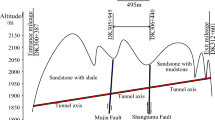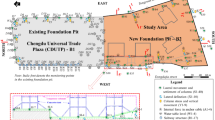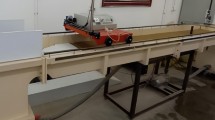Abstract
The asymmetric three-cabin structure is one of the favourite choices in urban utility tunnel engineering, as it can provide a higher space utilization and clearer classification for pipelines. However, few work has been done on utility tunnel in such special cross-section during undercutting construction until now. Besides, as the loose soil layers such as sand and silt are often encountered during the utility tunnelling, its influence on surface settlement become one of the main concerns. This study focuses on the influence of the construction scheme on the surface settlement details for an asymmetric three-cabin utility tunnel. A 3D finite element method (FEM) model was established including both the stratum and a utility tunnel based on the Beijing Daxing International Airport (BDIA) Expressway Urban Utility Tunnel project. With this model, the behaviour of the surface settlement with the undercutting construction of the utility tunnel was investigated, and the causes and values of surface settlement in five construction stages were analyzed. By changing the construction spacing and sequence of mid and side cabins, the surface settlement and structural deformation were compared. The numerical results demonstrated a strong correlation between the cross-section shape and surface settlement characteristics. And the symmetry line of the surface settlement trough was offset by 1 m to the side with the larger cross-section. The second (excavation of upper bench in mid-cabin) and fourth (excavation of upper bench in side-cabin) stages caused the largest surface settlement, which were 41.9% and 18.07% of the total settlement, respectively. In addition, after optimizing the field tunnelling scheme, the surface settlement was reduced by 31.9% using the side-tunnel first construction sequence. The proposed numerical model is able to predict the settlement characteristics in each construction stage, which is important and provides a basis for further studies on the surface settlement mechanism and optimal design of the asymmetric three-cabin utility tunnelling scheme.
Similar content being viewed by others
References
Bose T, Levenberg E (2020) A priori determination of track modulus based on elastic solutions. KSCE Journal of Civil Engineering 24(10):2939–2948, DOI: https://doi.org/10.1007/s12205-020-5372-5
Fang KD, Yang ZY, Jiang YS, Sun ZY, Wang ZY (2020) Surface subsidence characteristics of fully overlapping tunnels constructed using tunnel boring machine in a clay stratum. Computers and Geotechnics 125:103679, DOI: https://doi.org/10.1016/j.compgeo.2020.103679
Feng J, Yan C, Ye L, Ding X, Zhang J, Li Z (2019) Evaluation of installation timing of initial ground support for large-span tunnel in hard rock. Tunnelling and Underground Space Technology 93:103087, DOI: https://doi.org/10.1016/j.tust.2019.103087
Hou C-T, Yang X-L (2020) Seismic stability of 3D tunnel face considering tensile strength cut-off. KSCE Journal of Civil Engineering 24(7): 2232–2243, DOI: https://doi.org/10.1007/s12205-020-1804-5
Huang R, Xiao H (2010) Deformation mechanism of a shallow double-arch tunnel in a sloping rock mass. Bulletin of Engineering Geology and the Environment 69(1): 89–97, DOI: https://doi.org/10.1007/s10064-009-0240-z
Huang Z, Zhang H, Fu HL, Ma SK, Liu Y (2020) Deformation response induced by surcharge loading above shallow shield tunnels in soft soil. KSCE Journal of Civil Engineering 24(8):2533–2545, DOI: https://doi.org/10.1007/s12205-020-0404-8
Kang LS, Liu SF, Zhang HK, Gong DQ (2020) Person anomaly detection-based videos surveillance system in urban integrated pipe gallery. Building Research and Information 5:1–15, DOI: https://doi.org/10.1080/09613218.2020.1779020
Lai HP, Zhang J, Zhang LY, Chen R, Yang WJ (2019) A new method based on centrifuge model test for evaluating ground settlement induced by tunneling. KSCE Journal of Civil Engineering 23(6): 2426–2436, DOI: https://doi.org/10.1007/s12205-019-0780-0
Li L, Du X, Zhou J (2020) Numerical simulation of site deformation induced by shield tunneling in typical upper-soft-lower-hard soil-rock composite stratum site of changchun. KSCE Journal of Civil Engineering 24(10):3156–3168, DOI: https://doi.org/10.1007/s12205-020-0124-0
Li SC, Yuan C, Feng XD, Li SC (2016) Mechanical behaviour of a large-span double-arch tunnel. KSCE Journal of Civil Engineering 20(11):2737–2745, DOI: https://doi.org/10.1007/s12205-016-0456-y
Li M-G, Zhang Z-J, Chen J-J, Wang J-H, Xu A-J (2017) Zoned and staged construction of an underground complex in Shanghai soft clay. Tunnelling and Underground Space Technology 67:187–200, DOI: https://doi.org/10.1016/j.tust.2017.04.016
Lu DC, Lin QT, Tian Y, Du XL, Gong QM (2020) Formula for predicting ground settlement induced by tunnelling based on Gaussian function. Tunnelling and Underground Space Technology 103:103443, DOI: https://doi.org/10.1016/j.tust.2020.103443
Luo Y, Alaghbandrad A, Genger TK, Hammad A (2020) History and recent development of multi-purpose utility tunnels. Tunnelling and Underground Space Technology 103:103511, DOI: https://doi.org/10.1016/j.tust.2020.103511
Ma S, Liu Y, Lv X, Shao Y, Feng Y (2018) Settlement and load transfer mechanism of pipeline due to twin stacked tunneling with different construction sequences. KSCE Journal of Civil Engineering 22(10): 3810–3817, DOI: https://doi.org/10.1007/s12205-018-0302-5
Makana LO, Jefferson I, Hunt DVL, Rogers CDF (2016) Assessment of the future resilience of sustainable urban sub-surface environments. Tunnelling and Underground Space Technology 55:21–31, DOI: https://doi.org/10.1016/j.tust.2015.11.016
Min B, Zhang X, Zhang C, Gong Y, Yuan T (2018) Mechanical Behavior of double-arch tunnels under the effect of voids on the top of the middle wall. Symmetry-Basel 10(12):703, DOI: https://doi.org/10.3390/sym10120703
Pantelidis L (2019) The equivalent modulus of elasticity of layered soil mediums for designing shallow foundations with the Winkler spring hypothesis: A critical review. Engineering Structures 201:109452, DOI: https://doi.org/10.1016/j.engstruct.2019.109452
Qing LH, Qun FY, Jian YM (2018) Deep shanghai project - A strategy of infrastructure integration for megacities. Tunnelling and Underground Space Technology 81:547–567, DOI: https://doi.org/10.1016/j.tust.2018.08.008
Sharifzadeh M, Kolivand F, Ghorbani M, Yasrobi S (2013) Design of sequential excavation method for large span urban tunnels in soft ground - Niayesh tunnel. Tunnelling and Underground Space Technology incorporating Trenchless Technology Research 35:178–188, DOI: https://doi.org/10.1016/j.tust.2013.01.002
Shivaei S, Hataf N, Pirastehfar K (2020) 3D numerical investigation of the coupled interaction behavior between mechanized twin tunnels and groundwater - A case study: Shiraz metro line 2. Tunnelling and Underground Space Technology 103:103458, DOI: https://doi.org/10.1016/j.tust.2020.103458
Tu HL, Zhou H, Qiao CS, Gao Y (2020) Excavation and kinematic analysis of a shallow large-span tunnel in an up-soft/low-hard rock stratum. Tunnelling and Underground Space Technology 97:103245, DOI: https://doi.org/10.1016/j.tust.2019.103245
Valdenebro JV, Gimena FN (2018) Urban utility tunnels as a long-term solution for the sustainable revitalization of historic centres: The case study of Pamplona-Spain. Tunnelling and Underground Space Technology 81:228–236, DOI: https://doi.org/10.1016/j.tust.2018.07.024
Wang TY, Tan LX, Xie SY, Ma BS (2018a) Development and applications of common utility tunnels in China. Tunnelling and Underground Space Technology 76:92–106, DOI: https://doi.org/10.1016/j.tust.2018.03.006
Wang T, Wang X, Tan Z, Li K, He M (2018b) Studies on ground settlement and pre-arching stress of pre-cutting tunnelling method. Tunnelling and Underground Space Technology 82:199–210, DOI: https://doi.org/10.1016/j.tust.2018.08.021
Yan Q, Zhang C, Lin G, Wang B (2017) Field monitoring of deformations and internal forces of surrounding rocks and lining structures in the construction of the Gangkou double-arched tunnel - A case study. Applied Sciences-Basel 7(2):169, DOI: https://doi.org/10.3390/app7020169
Yang HQ, Liu F, Lin SZ (2020) Investigation on the 3D ground settlement induced by shallow tunneling considering the effects of buildings. KSCE Journal of Civil Engineering 24(2):365–376, DOI: https://doi.org/10.1007/s12205-020-2201-9
Yang X-L, Zhang R (2018) Limit analysis of stability of twin shallow tunnels considering surface settlement. KSCE Journal of Civil Engineering 22(5):1967–1977, DOI: https://doi.org/10.1007/s12205-017-1398-8
Zhang SB, He SY, Qiu JL, Xu W, Garnes RS, Wang LX (2020a) Displacement characteristics of an urban tunnel in silty soil by the shallow tunnelling method. Advances in Civil Engineering 2020: 3975745, DOI: https://doi.org/10.1155/2020/3975745
Zhang D, Hu ZP, Lu GG, Wang R, Ren X (2020b) Experimental study on deformation mechanism of a utility tunnel in a ground fissure area. Advances in Materials Science and Engineering 2020:6758978, DOI: https://doi.org/10.1155/2020/6758978
Zheng G, Tong JB, Zhang TQ, Wang RK, Fan Q, Sun JB, Diao Y (2020) Experimental study on surface settlements induced by sequential excavation of two parallel tunnels in drained granular soil. Tunnelling and Underground Space Technology 98:103347, DOI: https://doi.org/10.1016/j.tust.2020.103347
Acknowledgments
This study was supported by the Fundamental Research Funds for the Central Universities of China (2-9-2015-082) and the National Natural Science Foundation of China (41807230).
Author information
Authors and Affiliations
Corresponding author
Rights and permissions
About this article
Cite this article
Li, Z.C., Wang, G.H., Hao, J.W. et al. The Influence of Construction Scheme of Asymmetric Three-Cabin Utility Tunnelling on the Surface Settlement Behaviour. KSCE J Civ Eng 25, 3568–3582 (2021). https://doi.org/10.1007/s12205-021-1636-y
Received:
Revised:
Accepted:
Published:
Issue Date:
DOI: https://doi.org/10.1007/s12205-021-1636-y




